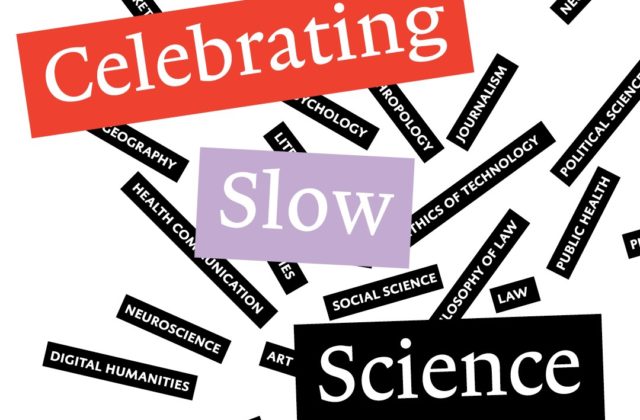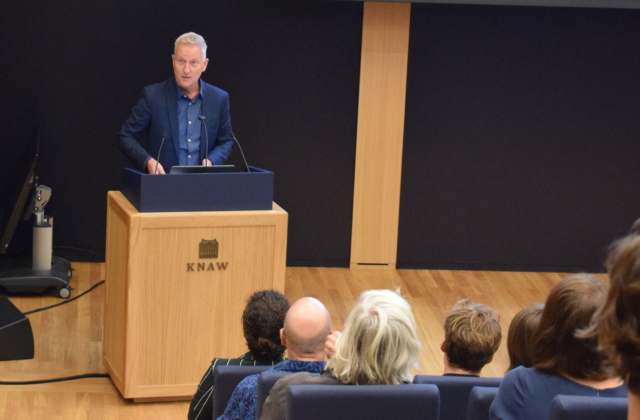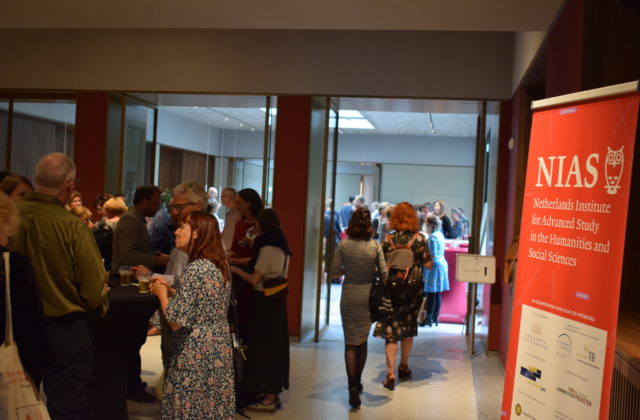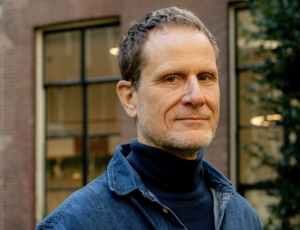
On Slow Science
Opening Speech of the Academic Year 2019/20 by Jan Willem Duyvendak
4 September 2019
“Welcome to NIAS, welcome to this opening of the academic year; welcome to all of you – in particular our new fellows. I have already had the pleasure of acquainting you with some of the characteristics of NIAS and there will be many more opportunities to do so, but today I will speak about Institutes for Advanced Study in general and reflect on what make these institutes so exceptional – so out of the ordinary.
The distinction between IASs and universities
Some of you might already be familiar with the histories of various Institutes for Advanced Study; all of you are likely to be aware of their present-day popularity; national institutes like NIAS as well as a growing number of university-based IASs. Why are they springing up all over the world and what can explain their immense popularity among scholars? What distinguishes IASs from the institutes of higher education in the Netherlands and elsewhere? Do these distinctions delineate a clear divide in academia or it a more of a gradient?
I will focus on one aspect that characterizes all institutes of advanced study: the ambition to practice and foster ‘slow science’. Other characteristics such as the blue sky-principle (scholars apply with a proposal on a topic of their own choice), interdisciplinarity and being part of an intellectual community are at least as important and as specific – but I will not deal with these today.
To understand an exception to the rule we have to ask ourselves what is ‘ordinary’: that is to say the situation in which most academics work. (Only a small group of scholars has the good fortune to come to an Institute for Advanced Study.) In many countries there are developments at universities that are worrisome and troubling: ‘corporate universities’ are emerging that do not embody the ideals for academia as articulated so well by Stefan Collini in his famous book What are universities for.
IASs have always embodied specific ideals for scientific endeavor – but these ideals were never meant to be exclusive or restricted to these institutes. We as, an IAS, strive to be a radical version of what a regular university should be about: a place where the precious commodities of time, space and an informal environment are provided to stimulate scientific serendipity, curiosity, and the production of the kind of knowledge that may not be immediately acknowledged by policy makers or businesses as being useful or functional. Academia, I argue, should be about the eagerness to know, to better understand our world, even if the generated knowledge cannot be immediately applied to solve the economic, ecological, financial or social problems of our day.
In other words, my plea this afternoon for ‘slow science’ is not to demarcate a line between the high-speed world of universities and the slow world of the IASs, but to take a critical look at the current situation in academia at large. I therefore invite you to think with us about the meaning and impact of ‘slow science’, a concept that NIAS has put into practice for some time now. This is the start of our conversation, I hope.
The Slow Science Movement
It is probably not a coincidence that a slow science movement has taken hold in several countries. There is a slow science manifesto and a website: www.slow-science.org and the movement is particularly strong in the humanities. In their recent book, The Slow Professor. Challenging the Culture of Speed in the Academy, authors, Maggie Berg and Barbara K. Seeber, explain the positive effects of slow science stating, “Slowing down is about asserting the importance of contemplation, connectedness, fruition, and complexity. It gives meaning to letting research take the time: it needs to ripen and makes it easier to resist the pressure to be faster; it gives meaning to thinking about scholarship as a community, not a competition” (2017: 57). Hence, slow science is not about doing the same thing at a slower pace, less speed, no, it is about creating conditions that allow vital aspects of research to flourish: space to ask new questions, to uncover and reconsider assumptions, to doubt.
The authors of The Slow Professor find parallels in totally different domains such as the slow food movement. They are clearly inspired when they quote the author of Slow Food Nation, Petrini, who writes: “Slow philosophy should not be interpreted as the contrast between slowness and speed –slow versus fast- but rather between attention and distraction; slowness is not so much a question of duration as an ability to distinguish and evaluate, with the propensity to cultivate pleasure, knowledge, and quality” (cited on pp. 89/90). This is probably the best way to frame it: slow science is not a goal in itself but it creates the opportunity for better science; a quantitative change, a slow down that promises qualitatively better, more interesting outcomes.
We should not claim that slowness is exclusively relevant for research, for academia. Slowing down can be pertinent in other sectors of society, as the slow food movement shows. But is it likely or even necessary that politics or the entire market sector will embrace the ideal of ‘slowness’? I think that it is more fruitful to argue that ‘slowness’ is one of the qualities defining good science and demarcating scholarship from other sectors such as financial markets and politics.

Autonomy of science
Demarcation, reflecting on the differences among spheres is traditionally done in terms of topographies: fields, spheres, sectors; boundaries drawn to protect the autonomy of science. Historically speaking this is very understandable. Think of the institutes for advanced study. Their histories are interesting in themselves (NIAS, the first European IAS following the original Princeton-model, is celebrating its 50th anniversary in 2021) – but also because they tell us a lot about the place of science in society, about the boundaries between society, the economy and academia, or the lack thereof. The start and development of Princeton’s IAS was directly related to the coming to power of German Nazism and the Nazification of German universities, pushing many scholars out of the country (and worse).
It is not a coincidence that totalitarian ideologies and regimes attack ‘free spaces’ of thought and research. For example the Collegium Budapest was one of the first institutions attacked by Orban. These are examples in which boundaries between spheres – in this case politics and science – are no longer respected; science becomes politicized and subordinated to political ideologies. The irony is that this usually happens when politicians claim that science has become ideological and too political. Take the example of gender studies, a well-respected discipline by now, that is disqualified as ‘gender ideology’, by political ideologues. Or the ridiculous accusation that ‘cultural Marxism’ is dominant within academia, as claimed by the leader of the populist party FvD in the Dutch senate.
Currently, many countries are seeing a rise in skepticism towards scientific inquiry as part of broad, often populist, movements that criticize all elites, including scientists. In these days of post-truth, everything can be fake and, therefore, science seems for some to have lost any credible claim to truth.
Doubtful slowness
The defense of the autonomy of science is necessary as is the defense of expertise as such. In the past, expertise has too often been blindly respected and, fortunately, that has changed, perhaps even overshot. We need to re-invent the specificity of science, of politics, of the arts and the economy.
‘Slowness’ can help us think about these differences, as the Dutch sociologist Dick Pels explains so well in his book Unhastening Science. Autonomy and reflexivity in the social theory of knowledge. Dick Pels is present here today and has been invited by NIAS to present his ideas regarding slow science at a public event in Spui 25, to be organized soon.
How then to define the fields of science, of politics, and the economy and the differences between them? Here, the idea of slow science comes in. Fields are not just different spatial entities; their specificity is partly defined by temporal differences. As Pels writes, “Good science requires a spatio-temporal disconnection that renders it legitimately and productively ‘out of sync’ with the more frenzied cultures. It occupies a special chronotope, a place of shelter and enclosure that favours particular forms of reflexive ‘unwinding’ or ‘chilling out’, and thus provides the essential time-scape for the cultivation of critical capacities. As both Plato and Nietzsche well knew, ‘untimely’ thoughts take time to develop, and hence can only mature if the thinker refuses to be synchronized into the fast pace of the utilitarian worlds of power, money and worldly fame.” (p. 9)
In this view, doubt plays an enormously important role. To quote Pels once more: “Entering a doubt is essentially a way of ‘buying time’ and of breaking the speed of thought in order to observe the item of interest from ‘close up’, to ‘give it another look’. This doubtful slowness escapes the conventional polarity between detachment and involvement, since it requires a passionate proximity to the object of investigation” (p. 195).
Hence, advocates of slow science have a strong idea about how scientific knowledge develops best; how innovation takes place. A quantitative change –slowing down- implies higher quality. Moreover, advocating slow science also implies an epistemological position regarding claims to truth since ‘slow’ scholars will, and should, always ‘take another look’ as scientific knowledge is by definition conditional, temporal in the sense of provisional. Slow science provides space for permanent doubt, rethinking, and collective learning.
This less frenetic kind of science is not exactly what we experience on a daily basis at our universities. Thinking about the value and the meaning of slow science is, therefore, not just about re-establishing boundaries between various spheres of society (in particular between science and politics) in terms of varying rhythms and pace. We also have to take a critical look at academia in many countries, in which at this moment only institutes for advanced studies seem to be geared to implement these ideals.
Bridging the gaps
The gap between universities on the one hand and institutes such as NIAS on the other hand, has become too wide. I celebrate that science at NIAS, in terms of pressure and pace, is probably the calmest, slowest and the least competitive place in the Netherlands. The time to reflect, to pause, to question, to invent, to read, to think has become scarce at many institutes for higher education. Nevertheless, I do not want NIAS to become popular because conditions at universities are deteriorating. I want NIAS (and other IASs) to be attractive because of our specific characteristics as a close-knit truly interdisciplinary intellectual community that is open, non-competitive, diverse and inclusive, also for writers, journalists and artists.
Some might object that embracing ‘slow science’ is a risky strategy, particularly for the social sciences and humanities, which are already under-valued as they are not considered of use in the utilitarian logic that is currently dominant in politics and the economy. Well, it may be risky but I think we have no choice: our value is that we are different; that we embody a logic and pace that will enrich society at large in the long term.
But don’t get me wrong. Emphasizing the specificity and the autonomy of academic spheres does not imply a plea for a return of ivory towers gazed at from a distance by those from outside academia. Slow science should be ‘out of sync’ with other spheres but never ‘out of touch’.
In fact, as many of you will hopefully have noticed, since NIAS moved to Amsterdam, we have been ‘opening up’, reaching out to new audiences and taking science (back) to the ‘public’. And we are committed to sharing scientific knowledge – our fellows’ knowledge – with various audiences and, so, foster contemporary political and public debates. Moreover, we want to intensify our institutional links with important organizations in civil society, the cultural world, businesses, politics, and particularly with the municipality of Amsterdam – represented here later this afternoon- as well as sponsors of NIAS-fellowships – many of them present here today.
The intense relations and cooperation we have with these organizations are based on the acknowledgement of our differences: sponsors provide the opportunity for fellows to carry out the research they want to do. Sponsors of NIAS-fellowships share the vision that the creativity of scholars is best guaranteed when they can work in ‘un-hastened’ conditions where not quantity counts – in terms of number of published articles or citations scores – but the quality of new insights.
So, slow science is not synonymous with idleness, lack of drive and ineffectiveness – a conclusion swiftly drawn in our country with its protestant work ethic. Slow science is in fact enervating and a valuable catalyst to encourage creativity and new insights. That is what a forward looking society needs.”

-

-

-

-
 Insights
InsightsWhat is recognition?